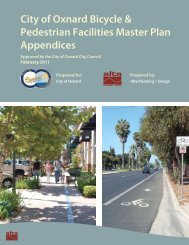Santa Clara River Trail Final Master Plan - Development Services ...
Santa Clara River Trail Final Master Plan - Development Services ...
Santa Clara River Trail Final Master Plan - Development Services ...
You also want an ePaper? Increase the reach of your titles
YUMPU automatically turns print PDFs into web optimized ePapers that Google loves.
<strong>Santa</strong> <strong>Clara</strong> <strong>River</strong> <strong>Trail</strong> <strong>Plan</strong><br />
existing facilities, route improvements, and bicycle support facilities. A jurisdiction may apply for<br />
funding to develop or update bicycle plans not more than once every five years.<br />
Air Pollution Buy Down Fees<br />
Another potential local source of funding is air pollution buy down fees, typically tied to trip generation<br />
rates and traffic impacts produced by a proposed project. As an alternative to paying impact fees, a<br />
developer may reduce the number of trips (and hence impacts and cost) by paying for on- and off-site<br />
bikeway improvements that will encourage residents to bicycle rather than drive.<br />
The City may assess impact fees for new development if a developer does not install improvements that<br />
reduce air pollution. The fees are assessed because the City requires transportation demand management<br />
(TDM) for new development. The impact fees are placed in the city’s air pollution buy down fund, which<br />
is the City’s off-site TDM fund recommended by the Air Quality Assessment Guidelines from the Ventura<br />
County Air Pollution Control District. The collected impact fees are allocated by the city council for<br />
projects to reduce single-occupancy vehicle trips and air pollution. Eligible projects include bicycle and<br />
pedestrian planning, bicycle lane striping, sidewalks, bike and pedestrian path acquisition and<br />
construction, and bicycle signage. Funds should not to be used for traffic improvements that do not<br />
principally benefit pedestrians, transit riders, and bicyclists. The Guidelines recommend the fees be spent<br />
or committed to a mitigation project within five years of receipt. Establishing a clear nexus or connection<br />
between the impact fee and the project’s impacts is critical in avoiding a potential lawsuit.<br />
Mello-Roos Community Facilities Act<br />
The Mello-Roos Community Facilities Act was created to compensate for the loss of funds created by the<br />
passing of Proposition 13. When financing for public services or improvements is needed, a Mello-Roos<br />
Community Facilities District (CFD) can be established to fund such necessities through a special tax on<br />
property owners in the area. Bicycle paths and bicycle lanes can be funded as part of a local assessment or<br />
benefit district. Defining the boundaries of the benefit district may be difficult unless the facility is part<br />
of a larger parks and recreation or public infrastructure program with broad community benefits and<br />
support.<br />
City of Oxnard | 111
















